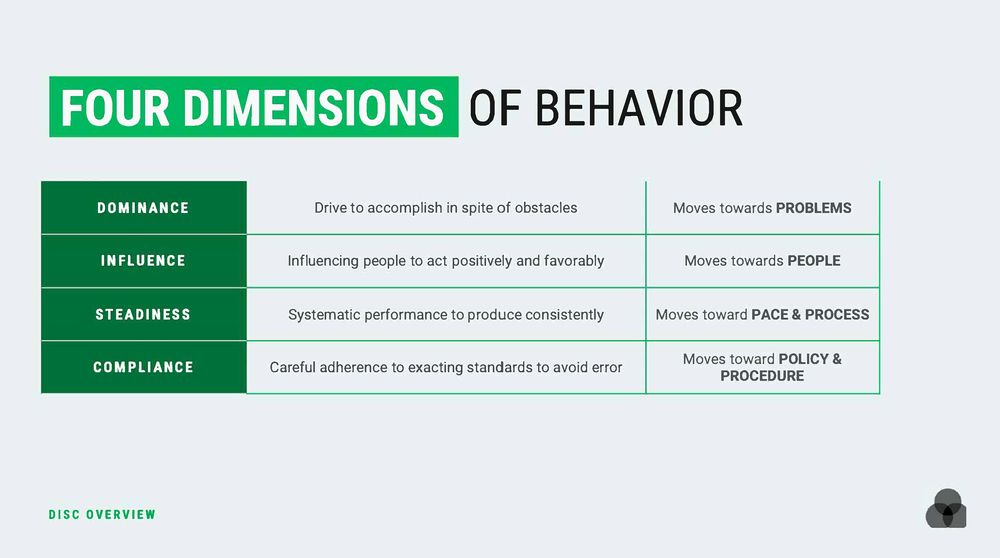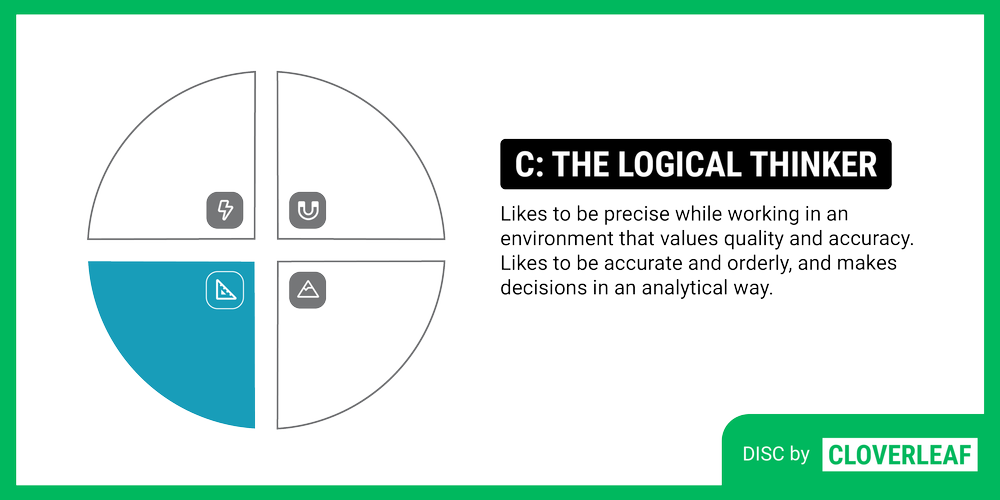Have you ever wondered why some colleagues seem to have a different approach to work than others? Or why do certain team members communicate differently or prioritize tasks in a particular way? Using DISC in the workplace can help teams understand one another’s behaviors and actions.
The DISC profile can help you understand yourself and your teammates because it identifies common patterns of behavior and motivation. The assessment is easy to comprehend, with only four parts: D, I, S, and C. Each letter represents a specific work style and describes the interests of each quadrant.
This post will explore using the DISC in the workplace to improve your team’s communication, collaboration, and productivity. You’ll also discover practical tips and strategies for working effectively with each type.
How Does The DISC Assessment Differ From Other Assessments?
The DISC assessment is unique in that it provides a simple, accessible way to understand and categorize behavioral tendencies, which can improve communication, teamwork, and leadership in various contexts. Other assessments may focus on different aspects of an individual’s personality or behavior, such as emotional intelligence, cognitive abilities, values, and motivating factors.
The DISC profile differs from other assessments in focusing specifically on an individual’s response to favorable and unfavorable situations. It measures their tendency toward four behavioral traits: dominance, influence, steadiness, and compliance. DISC provides insight into individual interactions and responses to stress and conflict.

Why Is DISC Important In The Workplace?
Incorporating DISC into the workplace can improve communication, giving and receiving feedback, and conflict resolution to enhance team performance. Managers can create a more cohesive and effective team by understanding each person’s motivational tendencies, communication styles, and cognitive diversity.
Understanding Motivational Tendencies
One of the primary benefits of using DISC in the workplace is its ability to provide information about the motivational tendencies of individuals. For example, individuals with high Steadiness scores may value cooperation and sincerity, while those with higher Dominance scores may prioritize pushing towards goals and outcomes. Understanding these tendencies can help managers better motivate and engage members of the team.
Enhancing Communication
DISC scores can also provide insights into effectively communicating with others. For instance, a team with a disproportionate number of high Dominance scores may create an environment where those with higher Steadiness or Compliance scores do not feel comfortable contributing ideas. Managers can create a more inclusive and productive environment by understanding different communication styles.
Depersonalizing Conflict
DISC can also help depersonalize conflict by providing a common communication language for a team. For example, using a team dashboard to display aggregate DISC results can help team members better understand each other’s conflict management styles and triggers. This can lead to developing a “conflict contract” that establishes group norms for dealing with conflict and helps generate team buy-in.
Capitalizing on Cognitive Diversity
Studies have shown that teams with higher cognitive diversity produce better outcomes. DISC can help teams understand their level of cognitive diversity and how to harness it to improve outcomes. Using the team DISC wheel, managers can see where the team lacks certain styles or where a member may play a critical role in achieving team goals.
Defining the Right Roles
DISC can help managers better understand how team members fit into their roles. Managers can create a more productive and engaged team using DISC to match individuals with roles that align with their behavioral patterns. Assigning tasks that conflict with their natural style may lead to burnout or turnover.

HUMAN SKILL PROGRAMS KEEP HITTING The SAME LIMITATIONS...
- Apply DISC results to real work tasks
- Tailor learning to who your people are, where they are
- Integrate learning so it is actually in the flow of work
- Scale human skills development
- Prove the ROI of your talent development programs
The D Type Personality In The Workplace
Dominance: Balancing Drive with Team Dynamics

The D in DISC stands for Dominance, which characterizes driven, goal-oriented, and assertive individuals. They are natural leaders who seek control and authority, viewing them as positive qualities. However, in their quest for success, D types may prioritize tasks and outcomes over the well-being and contributions of their co-workers.
High-D individuals must balance their drive for achievement with understanding how their actions affect their team dynamics. Overly focusing on tasks can dismiss the importance of building relationships and collaborating. This can ultimately hinder team success and create a hostile work environment.
Leaders with high-D traits can motivate their team towards a shared goal while creating a culture of openness, respect, and trust. By balancing their dominant nature with empathy and consideration for others, they can harness their strengths to achieve success for the team.
The I Type Personality In The Workplace
Influence: Harnessing Energy for Collaborative Success

“I” stands for Influence in the DISC model, representing individuals prioritizing social interaction and relationship-building. I types are energized by being around people and are drawn to change, seeing it as a positive force that can bring about new opportunities. They excel at connecting with others, using their charisma and personal skills to generate enthusiasm and excitement.
One potential downside of the I style is that their enthusiasm and love of variety can sometimes lead to impulsiveness and distractibility. They may lose sight of the end goal or become disorganized in pursuing new experiences. As a result, it can be helpful for Is to work with someone who can provide structure and help keep them focused on the task at hand.
Influencing types bring a valuable perspective to teams, and their ability to build relationships and generate excitement can help keep teams motivated and engaged. By understanding their strengths and potential pitfalls, Is can use their skills to benefit their team and the organization.
The S Type Personality In The Workplace
Steadiness: Fostering Team Harmony and Collaboration

These individuals are team players who prioritize a harmonious and inclusive team culture. They value stability and seek to create that for their team.
Others often consider them to be great listeners and have supportive teammates. They don’t like change or conflict and rarely initiate it, even if it costs them. It’s also essential to include them in any team decisions, give them ample notice if any changes need to be made, and seek their opinions.
S-Types like to ensure everyone is heard and foster a strong sense of connection among teammates. By understanding and leveraging the strengths of the S style, you can create a positive and supportive team environment.
The C Type Personality In The Workplace
Conscientiousness: Leveraging Attention to Detail for Team Success

The letter C represents traits that value a high focus on details and a desire for excellence. Individuals with this personality type are motivated to deliver quality work and are experts in their area of work. They hold themselves and their team to high standards and seek feedback to ensure their work meets expectations.
While conscientious individuals bring value to a team, they can find it stressful when faced with last-minute changes or rushed schedules. It’s important to give them adequate notice and allow them to work independently. They appreciate regular feedback but must be presented with kindness, as they can be sensitive to criticism.
These individuals thrive when given tasks that require attention to detail and expertise. They don’t need much collaboration or social interaction and may prefer to work from a private office or home. You can maximize their contribution to the team’s success by recognizing and leveraging their strengths.
How To Use The DISC Assessment With Teams?
The DISC circle illustrates how individuals with different personality types respond to change differently.
Responses to Change Based on DISC Types
The top of the circle represents the Ds and Is, who are drawn to change and view it as a positive force that can help them achieve their goals. In contrast, the Ss and Cs at the bottom of the circle are change-averse and can perceive change as an opposing force that may impede their effectiveness. They fear that chaos may arise in the team due to change.
People vs. Task Orientation
The DISC model further categorizes individuals into two groups based on their preference for people or task-oriented work. Those on the I and S side are drawn to people, collaboration, and service, and those on the D and C sides are attracted to tasks, execution, and accomplishment.
Effective Communication Strategies For Each DISC Type
The way people communicate also varies based on their place in the circle. Ds prioritize clarity over diplomacy and may come across as blunt, while Is focus on building relationships and connection.
Ss prioritize harmony and use soft-spoken, affirming communication, making direct communication difficult. Cs prioritize clear communication based on data and have a black-and-white approach to good and bad.
It’s helpful to slow down and use a measured approach when speaking to Ss and Cs, especially when giving feedback or asking for information. Providing notice and time to synthesize information is crucial for Ss and Cs.
Providing advanced notice about impending changes or project deadlines can help gain buy-in from Cs and Ss. Communicating how changes will benefit the organization or team can help achieve their support.
D and I personality types respond well to direct, confident, and energetic communication. They appreciate clear goals, objectives, and deadlines. When communicating with a D, it’s essential to be clear and concise, avoiding too much detail or ambiguity.
When communicating with an I, it’s important to be enthusiastic and engaging, using stories and anecdotes to keep their attention. They appreciate a more conversational tone and love to be recognized for their contributions.
D and I personality types appreciate a sense of urgency and enthusiasm in communication, and giving them space to express their ideas and opinions is important. They also respond well to visual aids and are more likely to be motivated by positive feedback and recognition than criticism.

Using DISC To Improve Communication During Team Meetings
During meetings, it’s important to be aware of communication patterns that can reveal someone’s DISC style. The Ds and Is tend to speak up first and express their opinions, while the Ss and Cs may reserve their comments. To ensure all members contribute, set aside time for Ss and Cs to provide feedback and opinions. For example, dedicating the last 15 minutes of the meeting can be effective. Creating a cadence for participation can also encourage involvement.
When Ds and Is lead meetings, ensuring everyone’s voice is heard is essential. They may assume that others will speak up if they have an idea, but encouraging participation is important. Awareness of each DISC type can help create routines that allow for informed decisions and ensure everyone’s voice is heard.
Using Cloverleaf's DISC Personality Test To Nuance Unique Personality Characteristics In The Workplace
DISC results often include a spectrum that reflects where individuals fall on each of the four quadrants. It’s possible for individuals to strongly prefer one quadrant or be more balanced, meaning they won’t have a dominant trait.

One of the unique features of the Cloverleaf DISC test is that it reveals some conflicting values that individuals may possess. For instance, individuals with a strong I and C may experience conflicting values because they enjoy a fast-paced environment with people and frequent changes from the I. Still, from the C, they also desire consistency.
Some characteristics may present less in individuals because they are self-regulating, which is a superpower. Balancing opposing values is a unique strength, as it allows one to see both sides of an issue.
Those with strengths in opposing quadrants, like IC and DS, have complementary strengths that can benefit a team without a partner or collaborator. This ability to see both sides of the picture can drive external collaboration and build consensus while maintaining attention to detail and striving for excellence.
In contrast, a traditional influence strength may become exhausted with detailed work. Still, someone with a balanced profile can have the energy to dig into the data and make new discoveries.
The rare combination of a high S and D result is present in only 2% of Cloverleaf users. These individuals possess a strong pioneering driver while valuing connection and being highly supportive of their team. They love change, power, and authority but also desire stability and harmony with others.
While some people with this combination may focus their drive inward rather than solely on achieving goals, it’s important to note that there is still a strong desire to move forward.
Conclusion
Each quadrant in the DISC profile is driven by particular questions that they find most important.
Ds are goal-oriented and prioritize understanding where they’re going and how to get there.
Influencers prioritize collaboration, resourcefulness, and the enjoyment of the task.
Steadiness drivers want to know how they will execute a task and how it will impact the team’s well-being.
Conscientious individuals want to understand the task, including its standards, expectations, and boundaries (such as time, resources, and commitments).
By using DISC in the workplace, you can tailor your communication and approach to meet their unique needs and preferences.
Understanding DISC results and the communication styles of each quadrant can significantly improve your team’s dynamics and productivity. By knowing the questions that each quadrant is interested in, you can communicate more effectively, meet everyone’s needs, and gain their buy-in faster.
Taking the DISC assessment and inviting your team to do the same can help you leverage everyone’s talents and gifts to achieve better results. Visit cloverleaf.me to start your profile and begin your journey towards better teamwork.



